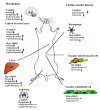Androgen receptor (AR) pathophysiological roles in androgen-related diseases in skin, bone/muscle, metabolic syndrome and neuron/immune systems: lessons learned from mice lacking AR in specific cells
- PMID: 24653668
- PMCID: PMC3960937
- DOI: 10.1621/nrs.11001
Androgen receptor (AR) pathophysiological roles in androgen-related diseases in skin, bone/muscle, metabolic syndrome and neuron/immune systems: lessons learned from mice lacking AR in specific cells
Abstract
The androgen receptor (AR) is expressed ubiquitously and plays a variety of roles in a vast number of physiological and pathophysiological processes. Recent studies of AR knockout (ARKO) mouse models, particularly the cell type- or tissue-specific ARKO models, have uncovered many AR cell type- or tissue-specific pathophysiological roles in mice, which otherwise would not be delineated from conventional castration and androgen insensitivity syndrome studies. Thus, the AR in various specific cell types plays pivotal roles in production and maturation of immune cells, bone mineralization, and muscle growth. In metabolism, the ARs in brain, particularly in the hypothalamus, and the liver appear to participate in regulation of insulin sensitivity and glucose homeostasis. The AR also plays key roles in cutaneous wound healing and cardiovascular diseases, including atherosclerosis and abdominal aortic aneurysm. This article will discuss the results obtained from the total, cell type-, or tissue-specific ARKO models. The understanding of AR cell type- or tissue-specific physiological and pathophysiological roles using these in vivo mouse models will provide useful information in uncovering AR roles in humans and eventually help us to develop better therapies via targeting the AR or its downstream signaling molecules to combat androgen/AR-related diseases.
Figures


Similar articles
-
Androgen receptor (AR) physiological roles in male and female reproductive systems: lessons learned from AR-knockout mice lacking AR in selective cells.Biol Reprod. 2013 Jul 25;89(1):21. doi: 10.1095/biolreprod.113.109132. Print 2013 Jul. Biol Reprod. 2013. PMID: 23782840 Free PMC article. Review.
-
New therapy via targeting androgen receptor in monocytes/macrophages to battle atherosclerosis.Hypertension. 2014 Jun;63(6):1345-53. doi: 10.1161/HYPERTENSIONAHA.113.02804. Epub 2014 Mar 31. Hypertension. 2014. PMID: 24688120 Free PMC article.
-
Androgen receptor roles in spermatogenesis and fertility: lessons from testicular cell-specific androgen receptor knockout mice.Endocr Rev. 2009 Apr;30(2):119-32. doi: 10.1210/er.2008-0025. Epub 2009 Jan 27. Endocr Rev. 2009. PMID: 19176467 Free PMC article. Review.
-
Monocyte/macrophage androgen receptor suppresses cutaneous wound healing in mice by enhancing local TNF-alpha expression.J Clin Invest. 2009 Dec;119(12):3739-51. doi: 10.1172/JCI39335. Epub 2009 Nov 9. J Clin Invest. 2009. PMID: 19907077 Free PMC article.
-
Androgen receptor (AR) differential roles in hormone-related tumors including prostate, bladder, kidney, lung, breast and liver.Oncogene. 2014 Jun 19;33(25):3225-34. doi: 10.1038/onc.2013.274. Epub 2013 Jul 22. Oncogene. 2014. PMID: 23873027 Review.
Cited by
-
Sex- and age-specific clinical and immunological features of coronavirus disease 2019.PLoS Pathog. 2021 Mar 26;17(3):e1009420. doi: 10.1371/journal.ppat.1009420. eCollection 2021 Mar. PLoS Pathog. 2021. PMID: 33770147 Free PMC article.
-
Transcriptional and Post-Transcriptional Regulations of Amyloid-β Precursor Protein (APP) mRNA.Front Aging. 2021 Aug 11;2:721579. doi: 10.3389/fragi.2021.721579. eCollection 2021. Front Aging. 2021. PMID: 35822056 Free PMC article. Review.
-
AKT3 deficiency in M2 macrophages impairs cutaneous wound healing by disrupting tissue remodeling.Aging (Albany NY). 2020 Apr 14;12(8):6928-6946. doi: 10.18632/aging.103051. Epub 2020 Apr 14. Aging (Albany NY). 2020. PMID: 32291381 Free PMC article.
-
Androgen-induced insulin resistance is ameliorated by deletion of hepatic androgen receptor in females.FASEB J. 2021 Oct;35(10):e21921. doi: 10.1096/fj.202100961R. FASEB J. 2021. PMID: 34547140 Free PMC article.
-
Identification of Potential Genes in Pathogenesis and Diagnostic Value Analysis of Partial Androgen Insensitivity Syndrome Using Bioinformatics Analysis.Front Endocrinol (Lausanne). 2021 Nov 18;12:731107. doi: 10.3389/fendo.2021.731107. eCollection 2021. Front Endocrinol (Lausanne). 2021. PMID: 34867780 Free PMC article.
References
-
- Accili D. Lilly lecture 2003: the struggle for mastery in insulin action: from triumvirate to republic. Diabetes. 2004;53:1633–42. - PubMed
-
- Albertelli M. A., Scheller A., Brogley M., Robins D. M. Replacing the mouse androgen receptor with human alleles demonstrates glutamine tract length-dependent effects on physiology and tumorigenesis in mice. Mol Endocrinol. 2006;20:1248–60. - PubMed
-
- Albright F. The effect of hormones on osteogenesis in man. Recent Prog Horm Res. 1947;1:293–353. - PubMed
-
- Almeida M., Han L., Martin-Millan M., Plotkin L. I., Stewart S. A., Roberson P. K., Kousteni S., O'Brien C. A., Bellido T., Parfitt A. M., Weinstein R. S., Jilka R. L., Manolagas S. C. Skeletal involution by age-associated oxidative stress and its acceleration by loss of sex steroids. J Biol Chem. 2007;282:27285–97. - PMC - PubMed
Publication types
MeSH terms
Substances
Grants and funding
LinkOut - more resources
Full Text Sources
Other Literature Sources
Research Materials

